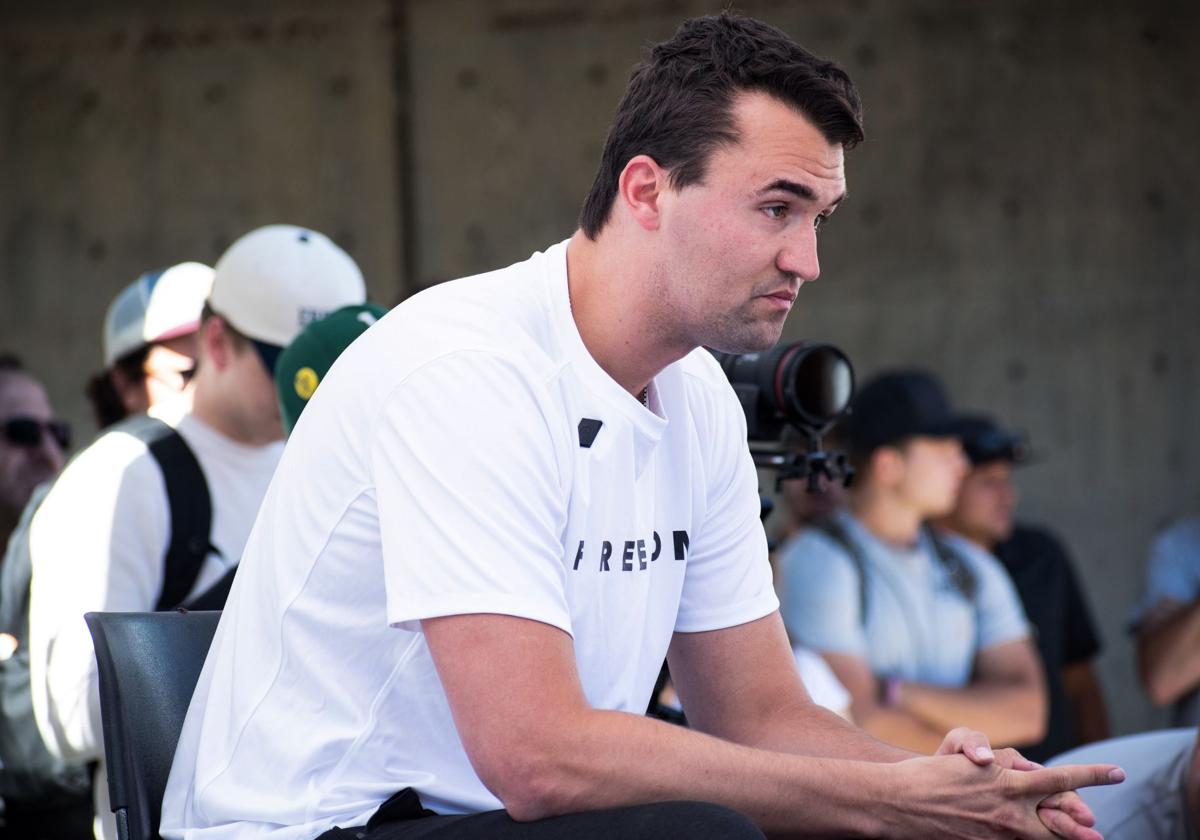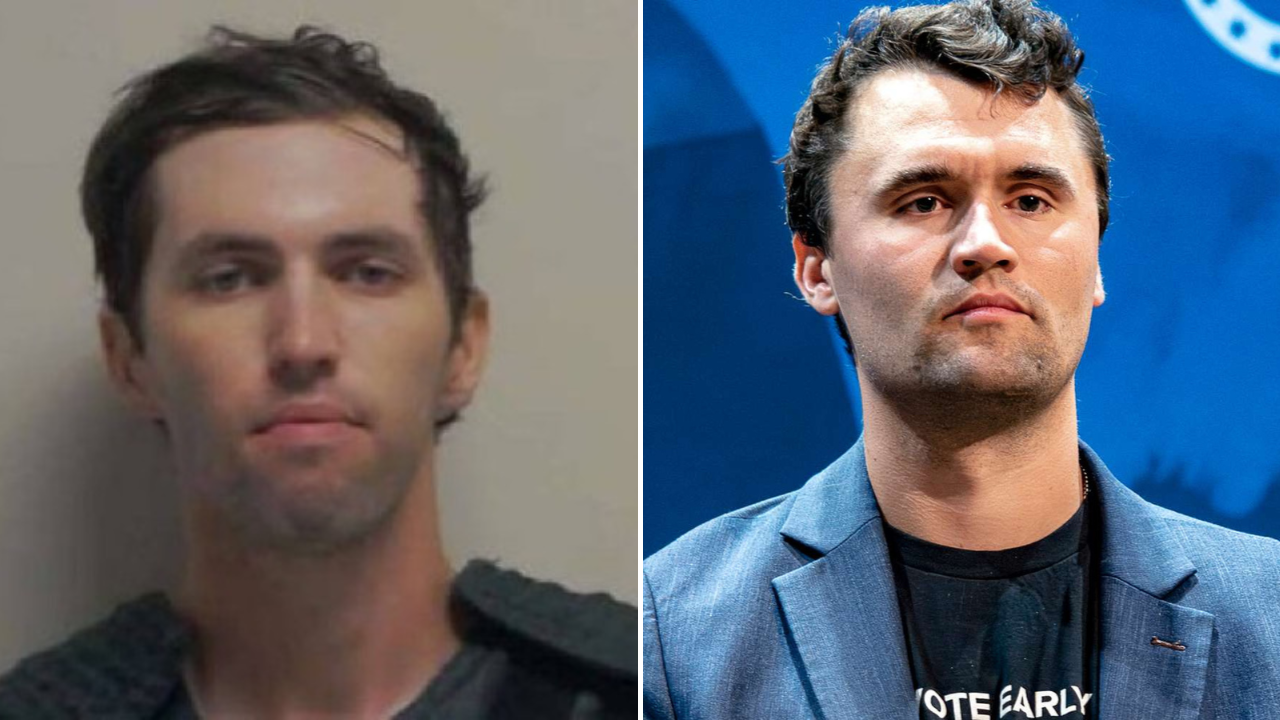“Signal lost. The convoy changed direction.” — But 47 minutes later, one truck driver’s story changed everything.
“Signal Lost. The Convoy Changed Direction.” — But 47 Minutes Later, One Trucker’s Story Changed Everything
There are moments when technology fails, when data vanishes, and when silence says more than words ever could.
But this wasn’t one of those accidents.
This was something else.
On a cold, quiet stretch of interstate, a high-profile federal convoy carrying an unnamed detainee simply—disappeared.
For 47 minutes
When the system came back online, the vehicles were miles off course, parked in a location never entered into the official itinerary.

And yet, within hours, the story was buried, the logs were “corrected,” and the only man who claimed to have seen what really happened was dismissed as unreliable.
But he wasn’t.
He was a truck driver — one who happened to be at the wrong rest stop at the wrong time, and saw something that still haunts him today.
A Glitch That Wasn’t Supposed to Happen
The first official report described it as a “technical synchronization failure.”
According to internal dispatch notes later leaked online, the message was chillingly simple:
“Signal lost. The convoy changed direction.”
That entry, timestamped at 21:03, was the last piece of data before a 47-minute blackout in the system. No visual feed, no dashcam recording, no location update. Just static.

By 21:50, the feed resumed. The convoy’s position had shifted roughly 19 miles east, now idling on a disused service road near an unregistered checkpoint.
The only problem? That road doesn’t exist on any public map.
When journalists first asked about the missing time, officials brushed it off. “Routine rerouting protocol,” they said. “No irregularities.”
But there were irregularities — plenty of them.
The Witness Who Shouldn’t Have Spoken
His name won’t appear in any official file, but the truck driver — referred to here as “Dale R.” — remembers everything in uncomfortable detail.
He was hauling refrigerated freight from Missouri to Ohio when he pulled into a
Nothing unusual — until one SUV broke formation and turned off toward the same service stop he was parked in.
“I thought they were just stopping for fuel,” Dale said. “But they didn’t use the pumps. They just sat there, engines running, lights off. Then another SUV — not part of the original group — showed up from the opposite direction.”
The two vehicles idled side by side for roughly five minutes. No one exited. Then, as quietly as they’d arrived, they drove off together, turning east instead of rejoining the main highway.

It wasn’t until the next day, when Dale heard about the 47-minute blackout on the radio, that he realized what he might have seen.
He reported it to local authorities — once.
The Report That Disappeared Overnight
Dale filled out a standard incident form and left his contact details. He says the officer who took his statement seemed “interested, even uneasy.”
But by morning, his report was gone.
“When I called back to check on it, they said no such report existed,” he recalls. “They told me maybe I’d talked to a county officer, not a state one. I knew that wasn’t true.”
Attempts to obtain a copy through open-record requests were denied under the pretext of “ongoing federal review.”
To this day, no agency has acknowledged receiving Dale’s statement.
47 Minutes of Silence
A leaked maintenance log from the Department of Transport’s internal monitoring system lists a “Data Stream Disruption – 47:16” at the same time the convoy went dark. The reason field was left blank.
According to one unnamed technician, the network never technically failed — it was manually disabled.

“You don’t lose every camera, every GPS unit, and every encrypted comms line simultaneously,” said the source, who claimed to have reviewed the raw telemetry. “That kind of blackout requires authorization from inside.”
When pressed, officials declined to confirm or deny any manual override. Instead, they released a two-sentence statement:
“All standard convoy protocols were followed. Any technical interruptions were resolved immediately.”
That single statement raised even more questions than it answered.
The Destination That Doesn’t Exist
Satellite data cross-referenced by independent analysts show that during the blackout, the convoy veered off its registered route — not toward a detour or checkpoint, but toward a stretch of
For years, that property has been listed as “inactive federal land — no public access.”
Yet tire impressions consistent with heavy transport vehicles were photographed there two days after the incident.
And then, they were paved over.
A week later, workers reported fresh asphalt and newly installed cameras at the site — cameras that, curiously, face inward instead of outward.
The Trucker’s Warning
Dale received an unexpected visit ten days after filing his initial statement. Two men in dark suits, identifying themselves only as “investigators,” showed up at his workplace.
“They asked a lot of questions — what I saw, who I told, if I had pictures,” he said. “When I asked who they worked for, they just said ‘transport oversight.’ One of them smiled and said, ‘You saw the wrong thing at the wrong time, friend.’”
That night, Dale deleted the photos he’d taken from his phone — grainy shots of two SUVs parked nose to nose under dim light. He said he was “done with it.”
But one file remained — automatically backed up to the cloud — and weeks later, that same image began circulating on online forums, watermarked with the words “47 MINUTES LOST.”
The Online Uproar
Within days, hashtags like #47MinutesLost and #ConvoyBlackout trended across platforms.
Independent researchers tried to trace the vehicles, comparing the body shapes and license plate shadows. None matched any federal registry.
Skeptics called it a “manufactured conspiracy.” Others claimed it was part of a classified handoff — a moment when the detainee was transferred off-record to a secondary unit.
No proof surfaced. But the lack of proof became the story itself.
Every time new evidence appeared, it disappeared just as fast.
Accounts posting satellite data were suspended. Archived screenshots vanished. Even Dale’s own Facebook profile — active for over a decade — was deleted “due to repeated identity verification failures.”
Coincidence? Maybe.
Or maybe someone was tidying up loose ends.
The Ghost Route
Transportation experts later discovered that the route used during the blackout was not random — it traced a corridor once used for classified logistics training in the early 2000s.
The road’s GPS signature was technically “retired,” meaning modern systems would ignore its coordinates unless manually entered.
That would explain why the convoy’s tracker showed nothing — it wasn’t that the signal disappeared. It was redirected into a ghost channel.
“That’s not a glitch,” said a retired routing engineer. “That’s a deliberate switch.”
If true, that means the convoy went exactly where it was told to go — off the map and off the record.
The Internal Memo
Weeks later, a fragment of what appeared to be an internal memo leaked from an anonymous email.
It read:
“Operational deviation approved.
Contact maintained under direct authorization.
External communication disabled for 47-minute interval.
Reentry confirmed, status stable.”
No names. No dates.
But the timestamp — 21:03 to 21:50 — matched perfectly with the recorded blackout.
Officials denied its authenticity, yet refused to provide the original documentation for comparison.
Reporters were told the file was “fabricated,” though none could explain how a forged memo contained time codes identical to federal transport logs.
Silence from the Top
In the months that followed, congressional inquiries briefly mentioned “a temporary routing anomaly.” No one pushed further.
An unnamed aide later told one journalist, “Some things are better left unconfirmed.”
For the families of those involved, that answer wasn’t enough.
“We’re not asking for secrets,” said one relative of a convoy officer. “We’re asking for the truth. Forty-seven minutes doesn’t just disappear.”
But disappear it did — from reports, from statements, and from public memory.
The Last Recording
Six months later, a digital forensics group claimed to have recovered partial audio from a damaged dashcam allegedly linked to one of the escort vehicles. The clip is short — 17 seconds — and distorted.
At the eight-second mark, a voice can be heard saying, “We’re not alone on this road.”
Then static.
The authenticity of the recording was never verified, but it reignited debate.
If there was another vehicle involved — a second convoy, an unmarked transfer, or something else entirely — then the 47-minute gap wasn’t an accident.
It was a meeting.
A Story That Refuses to Die
Every few months, new fragments resurface — anonymous emails, satellite screenshots, blurred security stills — each claiming to offer new proof.
Each time, agencies issue statements calling them “inaccurate,” “misinterpreted,” or “fabricated.”
And yet, the questions remain:
-
Why were all cameras and GPS systems disabled simultaneously?
-
Who authorized a detour to a restricted area?
-
Why was the only eyewitness report erased?
-
And most of all… what was being transferred during those missing 47 minutes?
No agency has ever provided a clear answer.
The Uncomfortable Pattern
Experts point out that this isn’t the first time a federal transport has gone “dark” mid-transit.
In 2017, a similar 26-minute gap was recorded during a classified operation in Nevada.
In 2020, two armored vans rerouted through private land for reasons never disclosed.
Each time, the explanation was “system malfunction.”
Each time, key witnesses were discredited or disappeared quietly from public view.
“It’s always the same,” said one retired convoy coordinator. “A blackout, a detour, a rewritten report. And then nothing.”
The Vanishing Data Trail
Forensic analysts who examined the recovered GPS files found that metadata from the blackout window had been deliberately overwritten, not corrupted.
In technical terms, that means someone manually replaced the data with blank timestamps.
That kind of override requires two-factor clearance — meaning, at least two authorized personnel had to sign off on it.
But no one has admitted to doing so.
And all personnel logs for that night remain “classified for national security purposes.”
Dale’s Final Words
Today, “Dale R.” lives quietly under a different name.
He doesn’t grant interviews anymore.
But in one of his last recorded statements, he said something that still echoes online:
“If what I saw was nothing, then why erase it?”
Those words have become a rallying cry for the online movement that refuses to let the 47 minutes be forgotten.
The Official Silence Continues
Federal spokespeople insist the event was “resolved internally” and pose “no public concern.”
But that silence — the lack of explanation, the missing files, the erased testimony — has only fueled suspicion.
Even today, requests for information about the convoy return the same automated reply:
“No records found.”
Yet people like Dale, the independent analysts, and countless others still believe there’s something deeper — something waiting behind those 47 missing minutes.
So What Really Happened?
No one outside the classified channels knows for sure.
But every trail leads back to one haunting possibility:
That the convoy didn’t lose signal.
It was told to disappear.
And for exactly 47 minutes, it did.
“The Betrayal No One Saw Coming — They Tried to Frame an Innocent Man”: Leaked evidence suggests Tyler Robinson was set up in a sinister plot, and Candace Owens claims the real culprit smiled directly at Charlie Kirk.

“The Betrayal No One Saw Coming — They Tried to Frame an Innocent Man”: Leaked evidence suggests Tyler Robinson was set up in a sinister plot, and Candace Owens claims the real culprit smiled directly at Charlie Kirk.
The world thought they knew the story. Charlie Kirk’s abrupt fall from the spotlight had been painted as a tragic event with a clear culprit: Tyler Robinson. But as new accounts emerge, and leaked evidence is examined, it appears that the public may have been misled all along.
Candace Owens, a long-time ally of Kirk, has stepped forward with explosive claims. She suggests that Tyler Robinson was not the mastermind, nor the person responsible. Instead, he was a convenient scapegoat in a complex plot, orchestrated by someone lurking in plain sight, smiling while chaos unfolded.
For months, the narrative had been carefully controlled. Media outlets, social commentary, and even online speculation seemed to point fingers at Robinson. But when Owens began revealing previously undisclosed messages, digital files, and witness accounts, the story shifted dramatically. The official account might not just be incomplete — it may be deliberately misleading.

Tyler Robinson – Innocent or Guilty?
Tyler Robinson had long been portrayed as a radicalized figure, allegedly tied to the incident involving Charlie Kirk. Yet insiders paint a different picture.
Robinson was, according to multiple sources, a private individual with no violent tendencies. His life, outside of the scrutiny he suddenly faced, was ordinary. Avid fishing trips, family gatherings, and community involvement marked his daily routine. There were no prior confrontations, no public statements hinting at malice, and no ties to political extremism.
The narrative that he confessed, or that his father turned him in, is now being described by sources close to Robinson as “complete fiction.” Documents and digital records examined by independent analysts suggest he might never have been near the location at the time of the incident.
Owens’s intervention added fuel to this reassessment. By releasing screenshots of emails, text messages, and legal memos, she demonstrated inconsistencies in the timeline used to implicate Robinson. Each piece of evidence suggests someone else had the opportunity, motive, and means to orchestrate the entire scenario.
Candace Owens Speaks Out
Candace Owens’ recent statements shook both supporters and critics alike. Her message was clear: Tyler Robinson was set up.
In a series of social posts and private communications, Owens outlined a scenario in which a carefully planned series of events was designed to misdirect the public and authorities. “They used Tyler as the perfect pawn,” she said in an interview, “while the real architect was smiling in Charlie’s face the whole time.”
Owens claimed to have evidence in the form of text messages, video footage, and witness testimonies showing discrepancies between what was reported and what actually occurred. Her warning was chilling: if the truth continued to be obscured, she would release her files publicly.
Her revelations encouraged a re-examination of the case. Legal experts and private investigators have noted that if her claims hold true, the misdirection could constitute a deliberate effort to manipulate public perception and possibly obstruct justice.
The Shadow in Plain Sight
The central mystery, according to Owens, is the “shadow figure” — an individual who allegedly orchestrated events behind the scenes.
Multiple witnesses recall a presence that went unnoticed at first, someone seemingly unremarkable yet strategically positioned. This figure’s role, as Owens outlines, may have been critical in ensuring Robinson appeared culpable while diverting attention from the true orchestrator.
Analysts who reviewed leaked footage describe anomalies: moments where security camera angles shift subtly, objects are placed unexpectedly, and timing discrepancies suggest a coordinated effort to control perception.
While the identity of this shadow figure remains officially unknown, Owens’ testimony implies it was someone close to Charlie Kirk — possibly within his inner circle. This revelation transforms the narrative from a simple tragedy to a web of deception, strategy, and hidden agendas.

The Evidence Trail
Owens has emphasized that documentation exists proving inconsistencies in official reports. Among the materials:
-
Emails and texts contradicting the official timeline.
-
Witness statements describing unusual behavior at the scene.
-
Digital files indicating that certain footage was reviewed but never publicly released.
Experts reviewing the evidence note that the discrepancies are not minor. Trajectory analyses, timing inconsistencies, and unexplained movements suggest someone manipulated events to craft a specific public perception.
While authorities maintain that Robinson remains implicated in some accounts, the mounting evidence challenges this version. Forensic analysts argue that if these claims are verified, the case may require a complete re-investigation.

Public Reaction and Speculation
Social media erupted after Owens’ revelations. Discussions spanned Twitter, YouTube, and independent forums, each theory more speculative than the last.
Fans of Charlie Kirk debated potential motives and alliances, while Robinson supporters rallied to defend his innocence. Online narratives emphasized the possibility that powerful figures were manipulating events for personal or political gain.
Despite the chaos, one thing is clear: the public is questioning everything they once accepted as truth. The “shadow figure” theory, Owens’ leaked evidence, and Robinson’s previously unseen alibi have created a narrative in which nothing can be taken at face value.
Implications for the Media and Authorities
If Owens’ claims are substantiated, media outlets, law enforcement, and even political commentators could face scrutiny. Analysts note that the framing of Robinson relied heavily on selective reporting, video editing, and narrative emphasis.
Authorities are now under pressure to explain gaps in the investigation, missing or suppressed evidence, and potential biases. Public confidence hinges on transparency — a challenge given the high-profile nature of the individuals involved.
Legal experts highlight that even the suggestion of a scapegoat being manipulated could lead to inquiries about obstruction, perjury, or evidence tampering. In short, the stakes are high — and the fallout could extend far beyond Robinson, Kirk, or Owens.

Conclusion and Next Steps
The unfolding saga demonstrates that initial appearances can be deceiving. Tyler Robinson may have been the perfect pawn, but the deeper story involves strategy, secrecy, and a shadowy figure manipulating events from behind the curtain.
Candace Owens’ revelations have reopened discussions about motive, opportunity, and truth. The leaked evidence challenges both the official story and widely circulated narratives, forcing investigators, journalists, and the public to reconsider what really happened.
As new developments continue, one question dominates: who is the real orchestrator, and how much has been hidden from public view? Until more concrete evidence is released, speculation will continue — and the mystery surrounding Charlie Kirk’s case remains as intense and compelling as ever.






